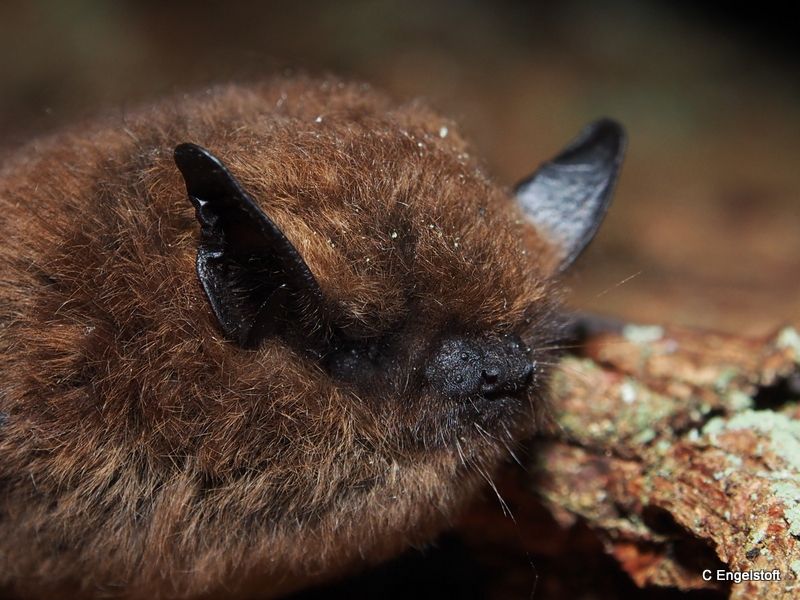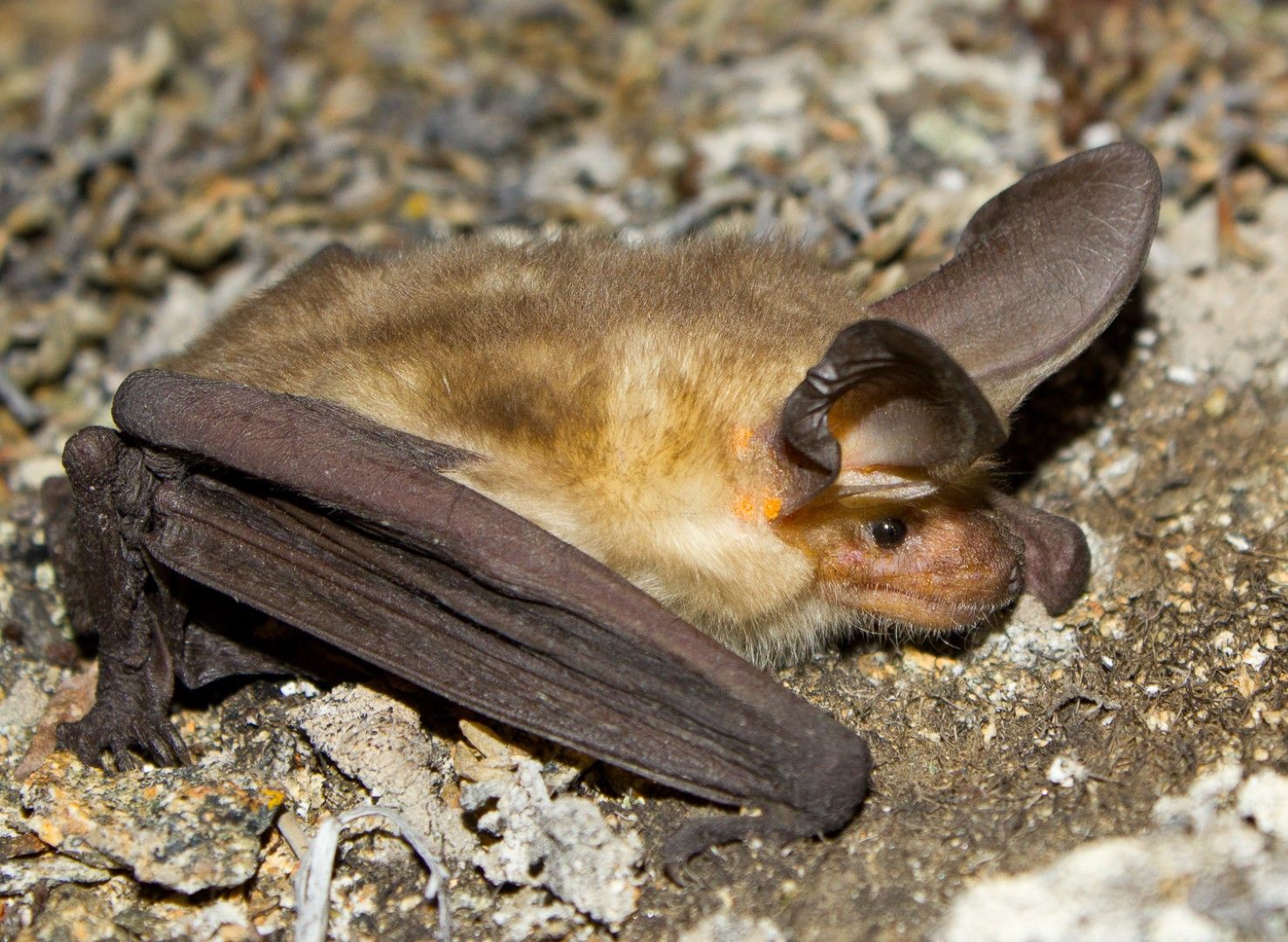We tend to talk about bats as if they were all identical in appearance, habitat, and habits. But that’s far from the truth. Cori Lausen is the Director of Bat Conservation with Wildlife Conservation Canada and lead author of the newly released edition of Bats of British Columbia. Cori emphasizes how much species diversity there is within this group of mammals. “It depends on where they roost, at what elevation, and their life history, such as whether or not they migrate,” Cori says. “They vary a lot in terms of how they produce their sound, which is based on body size and habitat.” She illustrates this point by describing 4 bats found in Western Canada.
Spotted Bat
Spotted Bats have black fur with 3 large white spots on their rump and shoulders as well as smaller white patches at the base of their pink ears, which are as long as their body. They are found in dry desert regions of the southern Okanagan and are extremely rare. Unlike many other bats, the Spotted Bats’ echolocation sounds can be picked up by the human ear as they are typically producing sounds as low as 7-12 kilohertz that sound like a series of clicks. The bats target a group of moths that have ears on the sides of their abdomens. The moths avoid other bat species as they can detect high-frequency sounds, but they’re unable to hear the low-frequency sounds of the Spotted Bat.
Bats cry 10 times per second, using up a lot of energy. “Bats are literally screaming,” Cori says. “The loudness of their sounds can be compared to holding a smoke detector to your ear. They scream multiple times each second. It could damage their ears, but it doesn’t as they’re able to disconnect the little bones in their ears so the sound isn’t as loud but then reconnect the bones to listen for the echo.”
Spotted Bats fly up very high and their sounds can travel a long distance. Their numbers are limited by the availability of day roosting sites in crevices of steep cliff faces such as those near Vaseux Lake and Lillooet.

Californian Myotis
Californian Myotis are small and dark. They spend most of their time in forested areas in southern BC as well as along the north coast. They fly slowly, but their small size helps them to maneuvre easily around trunks and branches. They emit a high-frequency sound that only travels a few metres, but that’s the area in which the bats are hunting. The high-frequency sounds come back with lots of information when they bounce off nearby objects enabling them to pick up on really tiny gnats. Larger bats making lower-frequency sounds wouldn’t even pick up on tiny insects.

Hoary Bat
Hoary Bats are one of Canada’s largest species with a wingspan of nearly 40 cm. They have long grey and brown fur tipped with white on their back. There are small patches of yellow fur around the face and wrists as well as on the shoulders and under the wings. They can be found in most parts of British Columbia, including Vancouver Island and the Interior as far north as Prince Rupert from May to October. Nothing is known about their winter habitat, but they are thought to travel hundreds or thousands of kilometres south.
Their thick fur probably serves as insulation, while the mottled colouring blends in well with lichen-covered bark. This camouflage is important because Hoary Bats just hang on the outside of trees during the day, among the leaves, unlike most other bats which hide away in various types of cracks.
Because Hoary Bats are migratory, they need to fly fast and high, which puts them at risk of getting hit by wind turbines. They hunt in open areas but must be close to tall trees to conceal themselves, which can cause problems for them when migrating if they’re unable to locate a suitable tree.
Because of their fast flight speed, the sounds they make to navigate and search for food (echolocation) are very low in frequency so the sound will travel far out in front of the bat to warn it of any objects in its way – much like headlights on a car at night. These sounds are so loud and low in frequency that young people with good hearing may be able to detect the Hoary Bats’ cries, which can be as low as 15 khz (humans pick up on sounds up to 12 khz; younger people, especially women, can hear even higher sounds). Their low-frequency calls are useful for fast flight, but they have a trade-off – only larger insects are likely to be detected, so this species typically hunts for large moths, beetles, and dragonflies.

Pallid Bat
Pallid Bats are almost as large as the Hoary Bat and have very large ears and eyes. They have pale yellow fur on their back and white fur on their underside. Unlike many bats, they catch lots of their food on the ground. Hovering just a few feet above the ground, they listen for the scree of a beetle. Once they’ve located their prey, they either land on top of it, covering it with its wings so it can’t escape, or chase it, using their really long thumbs and feet to run along the ground. The Jerusalem Cricket is one of their favourite catches, but they also trap and eat scorpions and are somehow resistant to the sting. Once the Pallid Bat has eaten, it uses its very strong leg muscles to bounce off the ground and become airborne. Most bats are unable to do this – instead they have to climb up a structure and then drop to take flight.
Pallid Bats normally roost in rock crevices or in Ponderosa Pines. The bats commute up to 4.5 km between their day roosts and foraging sites.
Pallid Bats are found from Mexico and the western United States as far north as the south Okanagan and possibly as far as Kelowna or even Kamloops. They are, however, very few and rare in British Columbia as over 67% of their natural grassland habitat has been taken over by orchards and vineyards. Research is underway to determine whether vineyards underplanted with native vegetation would provide a suitable foraging habitat for the bats. The bats’ ability to detect prey is severely limited by ambient noise that interferes with prey-generated sounds. This has significant implications for the Okanagan where irrigation pumps and other equipment are left running overnight in addition to road networks and energy development.
Bats of British Columbia
Bats of British Columbia by Cori L. Lausen, David W. Nagorsen, R. Mark Brigham, and Jared Hobbs is of interest to naturalists of all levels of expertise and is easy to read. There is an extensive section on bat biology, habitat, conservation, and threats, followed by an introduction to the 18 species found in British Columbia. The book provides a fascinating insight into where the bats are located, what they eat, where they spend the winter, and how they reproduce.
Further Information
Bats, Wildlife Conservation Society Canada
Pallid Bat Foraging Over Native and Vineyard Habitats in British Columbia, Canada [Canadian Journal of Zoology]
Bat Research & Education on the Prairies [EcoFriendly West]
Bats of British Columbia [Royal BC Museum]
Photo Credits
Spotted Bat, Michael Proctor
Californian Myotis, Christian Engelstoft
Hoary Bat, Cory Olson
Pallid Bat, Jared Hobbs (Bats of British Columbia)
